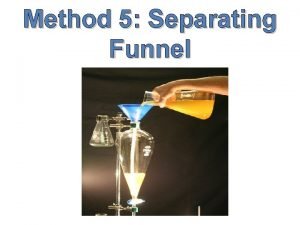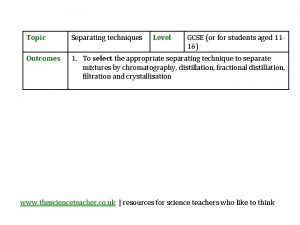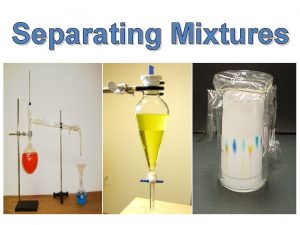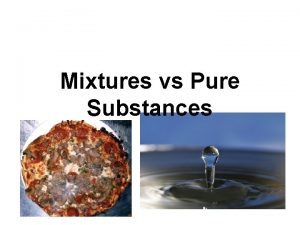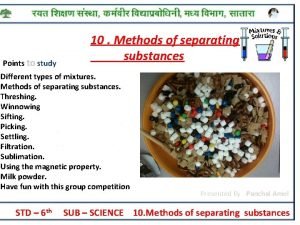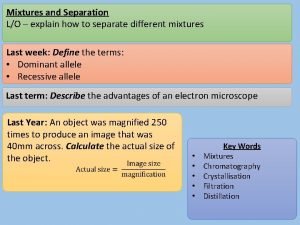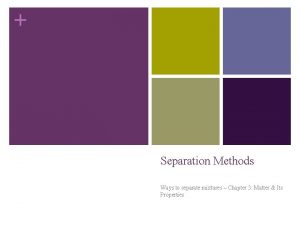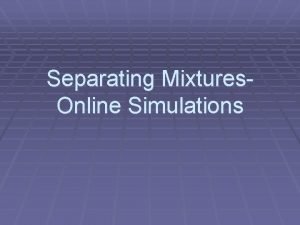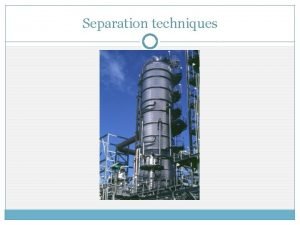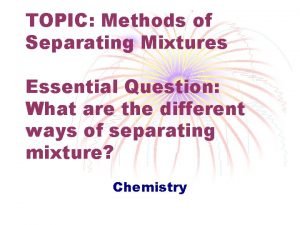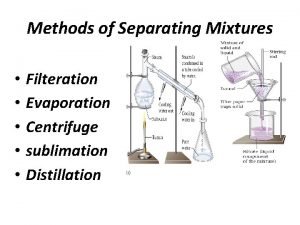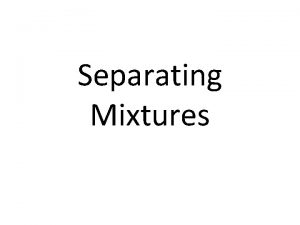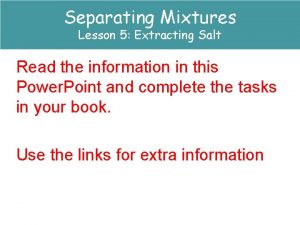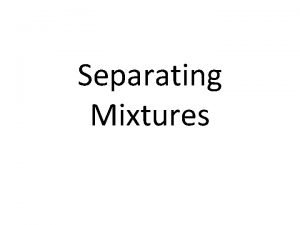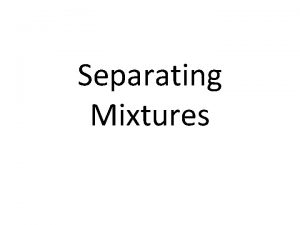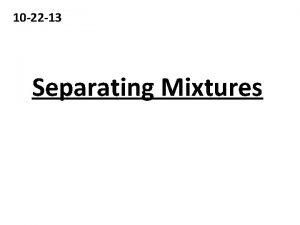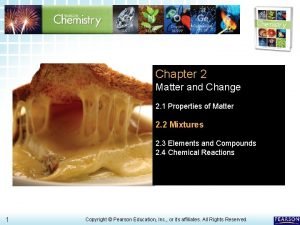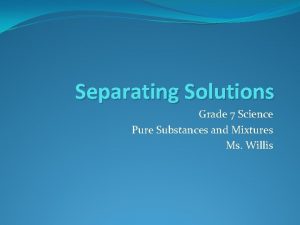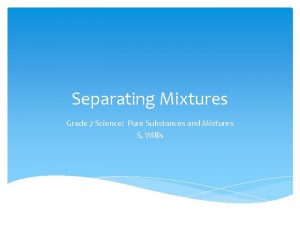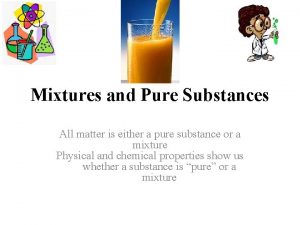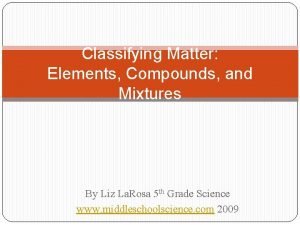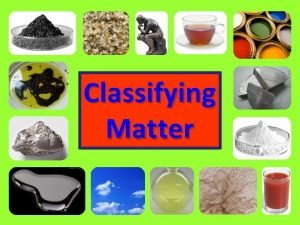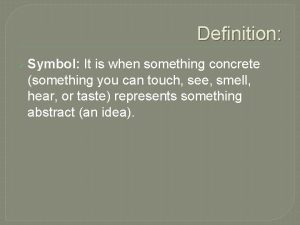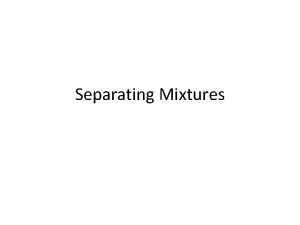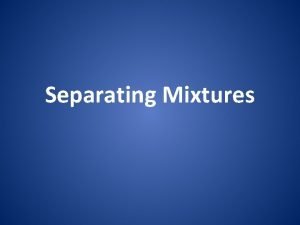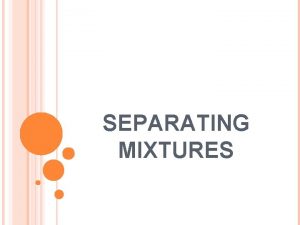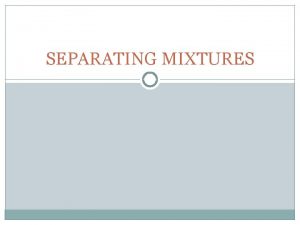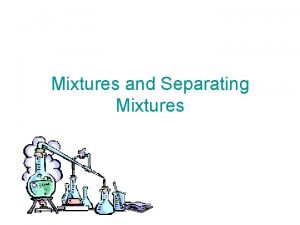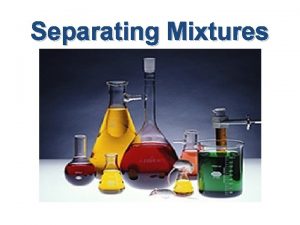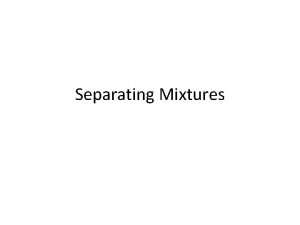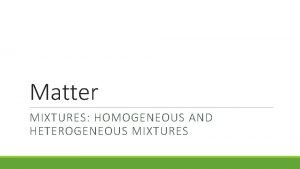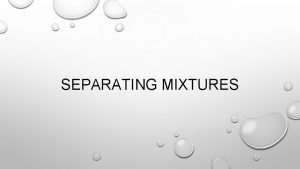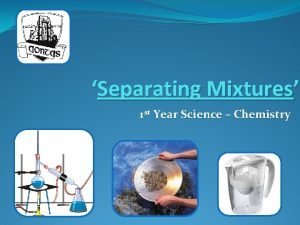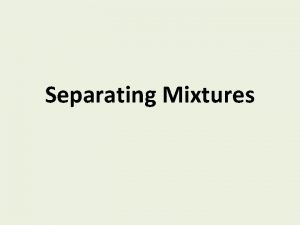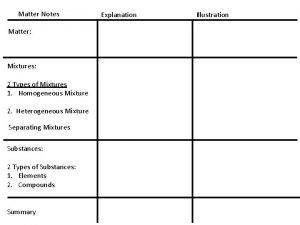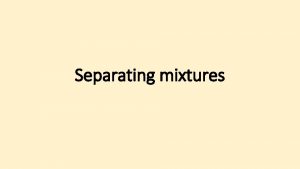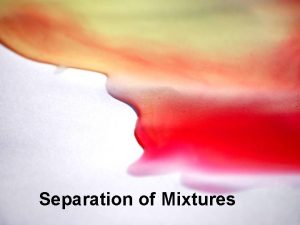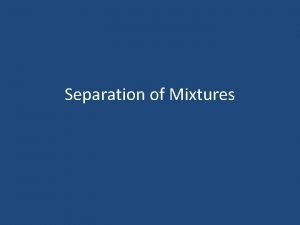The Organization of Matter Separating mixtures Something is































































- Slides: 63

The Organization of Matter

Separating mixtures • Something is a MIXTURE if it contains two (or more) substances that are not chemically joined together. • The substances in a mixture can often be easily separated from one another. • A PURE substance only contains one material and so cannot be separated in any way (unless a chemical reaction takes place)

MIXTURES • Mixtures are a physical blend of at least two substances; have variable composition. They can be either: 1) Heterogeneous – the mixture is not uniform in composition • Chocolate chip cookie, gravel, soil. 2) Homogeneous - same composition throughout; called “solutions” • Kool-aid, air, salt water • Every part keeps it’s own properties.

Homogenous Mixture • Is the type of mixture that has a completely uniform composition throughout itself. • It’s components are evenly distributed throughout the sample.

Solutions are Homogeneous Mixtures • Mixed molecule by molecule, thus too small to see the different parts • Can occur between any state of matter: gas in gas; liquid in gas; gas in liquid; solid in solid (alloys), etc. • Thus, based on the distribution of their components, mixtures are called homogeneous or heterogeneous.

Solutions Some common types of solutions System Examples Gas-gas CO 2 and O 2 in N 2 (air) Liquid-gas Water vapor in air Gas-liquid CO 2 in H 2 O (Soda water) Liquid-liquid Acetic acid in H 2 O (vinegar) Solid-liquid Na. Cl in H 2 O (brine) Solid-solid Cu in Ag (Sterling silver)

Heterogenous Mixtures • Is the type of mixture that is not uniform in composition. • If you were to sample one portion of such a mixture, it’s composition would be different from that of another portion.

What is phase? • The term “phase” is used to describe any part of a sample with uniform composition and properties. • A homogeneous mixture consists of a single phase • A heterogeneous mixture consists of two or more phase

Phases in a heterogenous mixture

Phases in a homogenous mixture

Homogenous or Heterogenous? 1. 2. 3. 4. 5. 6. Air Salt water Tea Brass Vinegar Hydrogen peroxide 7. Steel 1. 2. 3. 4. 5. 6. 7. Salad dressing Apple Sand Paint Granite Laundry detergent Cereal

Sieving • To understand that sieving is used as a means of separating materials by particle size. • To understand that particles smaller than the hole size of the sieve will pass through, and those that are larger will not. colander tea-strainer sieve remaining

Hand Separation / Mechanical Separation: • mechanical mixture can often be separated by hand or • by the use of a sieve or magnet.

Color differences in candy can be used as an analogy for separating solid-solid mixtures

Magnetic and electrostatic separation • Substances can be separated from each other using electromagnetic forces. • The effects of magnets and electricity can be seen in everyday life. • Refrigerator magnets stick to the steel surface of many refrigerators, and • Static electricity causes clothing to stick together once they come out of a dryer. • These forces can be utilised to help separate materials in suspensions.


Magnetic Separation • Magnetism affects certain kinds of metal, like iron and steel, but not others. • As a result, magnetism can be used to separate non-magnetic materials from ones that are attracted to magnets. • For example, scrap yards can remove scrap iron from other materials using a strong electromagnet. • If you were to mix iron filings in with a nonmagnetic material like powdered limestone, you could use a strong magnet to separate them back out again.

Sample Problem How can a mixture of iron fillings and aluminum fillings be separated? 1. Analyze: Plan a problem solving strategy List the properties of iron and aluminum and look for something that would be useful in separating the mixture 2. Solve: Apply the problem-solving strategy. Iron: Metal Grayish Not soluble in water Attracted to a magnet Aluminum: Metal Grayish Not soluble in water Not attracted to magnets Make use of a property that differentiates the metals; use a magnet to attract the iron fillings.

Sample Problem Continued 3. Evaluate: Does the result make sense? Because the magnet attracts iron but not aluminum filings, the iron would be removed while the aluminum would be left behind.

Sample Problem Continued 3. Evaluate: Does the result make sense? Because the magnet attracts iron but not aluminum filings, the iron would be removed while the aluminum would be left behind.

Practice Problems • What physical properties could be used to separate iron filings from salt? • Which of the following are homogenous? heterogenous? 1. Spaghetti sauce 4. Cough syrup 2. Glass 5. Mixture of nitrogen gas 3. Muddy Water and helium gas

Magnetic Separation One interesting heterogeneous mixture is iron fortified cereal. The iron can be removed by mixing the cereal with water and then using a magnet to extract the iron.

Electrostatic Separation • Electromagnetic forces can be used to separate nonmagnetic materials from other non-magnetic materials as well. • This is called electrostatic separation. • A simple form of electrostatic separation can be performed using a plastic comb and some peanuts with the skins still on. • Rub the peanuts so that the skins are easily separated from the peanuts. • Then rub the comb against something fuzzy (a woolly jumper would work well) and pass it over the peanuts. • The peanut skins should separate from the peanuts this way. • When you rub the comb against your jumper, it charges the comb. This is often referred to as static electricity. • Different materials are affected differently by these electrical charges. In our example, the peanut skins are affected more strongly than the peanuts themselves.

Question A) B) C) D) Which of these is electrostatic separation used for? Separating gold from gravel Cleaning smoke out of air in chimneys Separating scrap iron from other metals Sticking refrigerator magnets to the refrigerator

Settling: • Uses gravity to pull denser particles to the bottom of a mixture • Special Case: Centrifugation –Uses a machine (centrifuge) to spin the sample at high speeds to pull the particles down faster

SEDIMENTATION and DECANTATION

Centrifugation • A centrifuge separates a heterogeneous mixture of solid and liquid by spinning it. • After a successful centrifugation, the solid precipitate settles to the bottom of the test tube and the solution, called the cetrifugate, is clear.

Centrifugation Using a Centrifuge Balance with another test tube filled to the same level in the opposite holder. Close cover and turn knob. Centrifugation takes a minute or more. Note that you must turn off the centrifuge with the switch and wait for it to stop spinning, to effectively separate the precipitate and solution.

Filtration: • Allows the separation of solids from liquids or gases Ex. Air filters • The solid which remains behind on filter paper is called the residue • The liquid which passes through filter paper is called the filtrate

Filtration Continued: • NOTE: – Filtration cannot be used to separate dissolved solids from a liquid. – Filtration only works when the solid particles present are big enough to be seen; smaller particles (such as dissolved salt) simply pass right through the filter paper.

What type of mixtures will filtration separate? • Filtration can remove suspended material from water as long as the pores in the filter paper are smaller than the particles of the suspended substance. • Filtration is done by passing a mixture through a filter. • The residue is the substance that remains on the filter paper. • The filtrate is the substance that flows through the filter paper

Filtration • Filtration is pooring the mixture through a filter paper which allows the liquid to pass through and leaves the solid behind • Filtration separates a liquid from a solid.

Filtration is another method to separate a solid from a liquid

Separating Mixtures • Some can be separated easily by physical means: rocks and marbles, iron filings and sulfur (use magnet) • Differences in physical properties can be used to separate mixtures. • Filtration - separates a solid from the liquid in a heterogeneous mixture (by size)


MAKING ROCK SALT PURE Rock salt is a MIXTURE of several substances. In order to make pure salt it is necessary to remove the INSOLUBLE dirt from the SOLUBLE salt. [Note: The method described below could be used to separate any two substances when one of them can dissolve in water and the other cannot] 1. CRUSH the rock salt using a mortar and pestle. This makes the salt dissolve more easily. 2. STIR the crushed salt into a beaker of warm water. The salt will DISSOLVE into the water but the dirt, which is insoluble in water, will not. 3. FILTER the mixture. The dirt will get caught in the filter paper as a residue and the clear SALTY WATER will drip through and form the filtrate. 4. Warm the filtrate in an evaporating basin. The water will EVAPORATE leaving behind pure salt crystals. The heat is stopped BEFORE all of the water has evaporated. This makes the salt more pure and helps prevent the evaporating basin from cracking. The last little bit of salty water is filtered out

Different ways of separating mixtures 1. A magnet can be used to separate IRON from SAND. How it works: The magnet sticks to the iron but not to the sand 2. Filtering (filtration) can be used to separate a solid (or suspension) from a liquid. • How it works: The liquid (and anything dissolved in the liquid) passes through holes in the filter paper but the solid particles are too big and get stuck. • Example: Filtration would be used to separate the dirt from some salty water. 3. Evaporation can be used to separate a dissolved SOLUTE from a SOLUTION • Example: Evaporation would be used to obtain some pure salt from salty water. • How it works: When salty water is warmed the water evaporates leaving behind crystals of salt.

Words to know • Mixture: Something that can be SEPARATED into two (or more) different substances. eg air, sea water, earth, orange juice. • Pure: A material is pure if it contains only one chemical substance and so cannot be separated further Filtrate: The clear liquid that has been filtered. • Residue: The solid left behind after an experiment (eg the solid left in the filter paper). • Filtration: The process used to separate a solid (or suspension) from a liquid. • Suspension: Very fine particles of solid mixed with a liquid. If the solid is in suspension the water will often look cloudy. eg flour and water shaken together. • NOTE: in a suspension the solid has not dissolved but in a solution it has. • Soluble: Can dissolve • Insoluble: Cannot dissolve • Solvent: The liquid that is used to make a solution • Solute: A substance that has been dissolved in a solution.

Quiz • You have the following mixture. – Gravel, sand salt – Describe in steps how you would separate this mixture. – Be sure to name the appropriate separation technique.

Distillation is the process by which a mixture is separated by heating a solution and condensing using a cooling tube. The solution is boiled and steam is driven off.

Distillation Salt remains after all water is boiled off.

Distillation takes advantage of different boiling points. Na. Cl boils at 1415 o. C but H 2 O boils at 100 o. C

Making water pure • Water can be purified by a process called DISTILLATION. • eg: If we wanted to make some PURE WATER from SEA WATER we would distill the sea water. • The water in the flask EVAPORATES and turns into steam. • Anything dissolved in the water cannot evaporate and so remains in the flask. • The steam CONDENSES in the delivery tube and turns back into water which collects in the test tube. • The liquid that condenses in the test tube is known as the distillate

Simple Distillation is a technique used to purify a liquid.


Quiz Suppose you had a mixture of iron nails, salt and water. . . • How would you separate this mixture completely? • Based on which physical properties would you base your method on?

Quiz • How would you separate the components in tap water? • Based on which physical properties would you base your method on?





Separation of a sand-saltwater mixture

Extraction is the transfer of a solute from one phase to another.

Types of Extraction • Can use most any combination of phases (solid, liquid, gas. ). • Solid – Liquid Useful for the isolation and purification of naturally occurring sources. Making coffee is an example for extraction.

Types of Extraction • Liquid – Liquid More common method Depend on solubility properties of components. Like dissolves like So ideally, the extracting solvent should be similar to the solute. We will use two immiscible liquids like vinegar and olive oil.

EXTRACTION • • • pouring a mixture of oil and water together, all mixed up, into the funnel the oil and water separate and the oil floats on top of the water a hole opens under the funnel and the water leaves, and the oil remains

Chromatography • This animation shows what happens to a mixture of two dyes. • The green and yellow dyes can be separated. • The green dye moves along with the solvent better than the yellow dye. • The mixture is separated into two "spots". • There are two substances in the mixture. • Water can be used as a solvent but so can other liquids if need be.

Paper Chromatography Components of dyes such as ink may be separated by paper chromatography.




REFERENCES • • • http: //www. wiziq. com/tutorial/38393 -Separation-of-Substances http: //www. tutorvista. com/content/chemistry/general-chemistry/ismatter-around-us-pure/fractional-crystallization. php http: //www. rpdp. net/sciencetips_v 2/P 12 A 3. htm http: //www. 800 mainstreet. com/e 3. html http: //www. saskschools. ca/curr_content/science 10/unita/redon 17. html http: //www. chemilp. net/lab. Techniques/Fractional. Distillationl. Animation. htm http: //www. tutorvista. com/content/chemistry-iii/metals/frothfloatation. php http: //highered. mcgrawhill. com/sites/0072495855/student_view 0/chapt er 2/animation__how_osmosis_works. html http: //www. tutorvista. com/content/biology/humanphysiology/excretory-system/artificial-kidneys-the-dialysismachine. php http: //www. kidneypatientguide. org. uk/site/HDanim. php http: //orgchem. colorado. edu/hndbksupport/ext. html

REFERENCES • http: //www. colour-ed. org/activity/act_01/01_index. htm • http: //www. skwirk. com. au/p-c_s-16_u-195_t-542_c 2021/magnetic-and-electrostatic-separation/nsw/// • http: //www. mikecurtis. org. uk/mixtures. htm • http: //www. tutorvista. com/content/chemistryi/elements-compounds/sand-water. php • http: //www. dartmouth. edu/~chemlab/techniques/centrifuge. html • http: //www. wonderhowto. com/how-to-perform-centrifugationchemistry-lab-269378/ • http: //www. chemilp. net/lab. Techniques/Solvent. Extraction. Animation. htm • http: //www. wfu. edu/biology/albatross/atwork/sepfun_high. htm
 What is a separating funnel
What is a separating funnel Separating mixtures gcse
Separating mixtures gcse Why is it important to separate mixtures
Why is it important to separate mixtures Is tomato juice a pure substance
Is tomato juice a pure substance Sublimation process
Sublimation process Pure substance
Pure substance Crystallization
Crystallization Fossweb mixtures and solutions
Fossweb mixtures and solutions Examples of
Examples of Objectives in separating mixtures
Objectives in separating mixtures Centrifuge separating mixtures
Centrifuge separating mixtures Sublimation
Sublimation Evaporation separating mixtures examples
Evaporation separating mixtures examples Chemistry separating mixtures worksheet
Chemistry separating mixtures worksheet Example of sifting
Example of sifting Example of magnetism in separating mixtures
Example of magnetism in separating mixtures How to separate salt and sand
How to separate salt and sand Destilstion
Destilstion Separating mixtures grade 7
Separating mixtures grade 7 Separating mechanical mixtures
Separating mechanical mixtures Natural science grade 7 lesson plans term 2
Natural science grade 7 lesson plans term 2 14. separating mixtures of liquids.
14. separating mixtures of liquids. What is a mechanical mixture
What is a mechanical mixture Types of matter elements compounds and mixtures
Types of matter elements compounds and mixtures How is matter classified
How is matter classified Something old something new poem
Something old something new poem Describing something by comparing it to something else
Describing something by comparing it to something else With symbolism authors use concrete objects to represent
With symbolism authors use concrete objects to represent Is adjective a language feature
Is adjective a language feature Something concrete that represents something abstract
Something concrete that represents something abstract For explanation purpose
For explanation purpose When something represents something else
When something represents something else Smart is something you become not something you are
Smart is something you become not something you are Composition of matter section 1
Composition of matter section 1 Classification of matter section 1 composition of matter
Classification of matter section 1 composition of matter Gray matter and white matter
Gray matter and white matter Chapter 2 section 1 classifying matter answers
Chapter 2 section 1 classifying matter answers Grey matter and white matter in brain
Grey matter and white matter in brain Section 1 composition of matter
Section 1 composition of matter Gray matter and white matter
Gray matter and white matter Flow of energy vs flow of matter
Flow of energy vs flow of matter Gray and white matter
Gray and white matter Process organization in computer organization
Process organization in computer organization Block organization
Block organization Thiếu nhi thế giới liên hoan
Thiếu nhi thế giới liên hoan Tia chieu sa te
Tia chieu sa te Các châu lục và đại dương trên thế giới
Các châu lục và đại dương trên thế giới Một số thể thơ truyền thống
Một số thể thơ truyền thống Thế nào là hệ số cao nhất
Thế nào là hệ số cao nhất Frameset trong html5
Frameset trong html5 Sơ đồ cơ thể người
Sơ đồ cơ thể người Thế nào là số nguyên tố
Thế nào là số nguyên tố Tư thế ngồi viết
Tư thế ngồi viết đặc điểm cơ thể của người tối cổ
đặc điểm cơ thể của người tối cổ Cách giải mật thư tọa độ
Cách giải mật thư tọa độ Thang điểm glasgow
Thang điểm glasgow ưu thế lai là gì
ưu thế lai là gì Thẻ vin
Thẻ vin Cái miệng bé xinh thế chỉ nói điều hay thôi
Cái miệng bé xinh thế chỉ nói điều hay thôi Các châu lục và đại dương trên thế giới
Các châu lục và đại dương trên thế giới Bổ thể
Bổ thể Từ ngữ thể hiện lòng nhân hậu
Từ ngữ thể hiện lòng nhân hậu Diễn thế sinh thái là
Diễn thế sinh thái là Tư thế ngồi viết
Tư thế ngồi viết
